A history of syringes and needles
Syringes were invented long before hypodermic needles. Their origins are found in Greek and Roman literature where there are descriptions of hollow reeds for the ritual of anointing the body with oil, and as musical instruments using a plunger to alter the pitch. Simple piston syringes for delivering ointments and creams for medical use were described by Galen (129-200 CE) and an Egyptian, Ammar bin Ali al-Mawsili, reported using glass tubes to apply suction for cataract extraction from about 900 CE. In 1650, Pascal’s experimental work in hydraulics stimulated him to invent the first modern syringe which allowed the infusion of medicines. Christopher Wren (better known as an architect than for his medical training), used a ‘cut-down’ technique to intravenously inject dogs with poppy sap through goose quill canulae. By 1660 Drs Major and Esholttz used this method on humans with similar fatal results due to ignorance of suitable dosage and the need for sterilising utensils and the infusion. The disastrous consequences of these experiments delayed the use of injections for 200 years.
The first hypodermic needle was probably made by Francis Rynd in Dublin in 1844, using the technology of annealing the edges of a folded flat strip of steel to make a tube. This was then drawn through increasingly narrower dies whilst maintaining the patency of the needle. The bevelled point is cut and ground, and then the hub is added with its variety of fittings and locks. A syringe has three elements, the barrel (glass, plastic or metal), the plunger and the piston which may be of rubber, mineral, metal or synthetic material but in early examples waxed linen tape or asbestos was wound on a reel to obtain a watertight seal. Charles Pravaz, in France, administered coagulant to sheep in 1853, but it seems that Alexander Wood in Edinburgh combined a functional syringe with a hypodermic needle in the same year, to inject morphine into humans and probably should be credited with inventing the technique. The basic design has remained unchanged though interchangeable parts and the use of plastic resulted in the almost universal use of disposable syringes and needles since the mid-1950s.
Looking to the future of the parenteral administration of medicines and vaccines, it’s likely that there will be increasing use of direct percutaneous absorption, especially for children. Micro-silicon-based needles, so small that they don’t trigger pain nerves are being developed, however, these systems cannot deliver intravenous or bolus injections so hypodermic needles, with or without syringes, are likely to be with us for a long time. They are also required for catheter-introduced surgical procedures in deep anatomical locations.
Some needles from the collection:
Figure 1 shows three generations of needles. The top left ones are single-use needles from the 1950s with various lengths and gauges. At the top right is small sample of needles of a currently used type, supplied in a patent wrapper in their individual protective sheathes, with colour coded plastic hubs. Below these are the 1930s screw-on double ended needles patented by Boots & Co Ltd to fit their cartridge loading syringes. The internal point pierced the rubber bung on pre-dosed cartridges which could be inserted in the patent syringe.
The range of needles is extensive. Each manufacturer produced a different shaped hub. Also, the taper of the nozzle was non-standard though most used were the ‘Luer’ and then the more tapered ‘Record’ but in addition to this were different locking devices to fit different syringe nozzles. The gauge and length of needles varies greatly according to their purpose. Figure 2 illustrates infusion needles in which the bulbous hub fits directly on to rubber tubing. Pneumothorax needles are for withdrawing air from the pleural cavity. The side arm allows for the attachment of a suction bottle using a two-way tap. The Hamilton Bailey type infusion canulae needles are eight from the early 20thcentury, made of gold for sterility, with slots through which to thread a support tape. Figure 4. Shows aspiration needles. They have a bevel-pointed introducer to facilitate insertion of the needle.
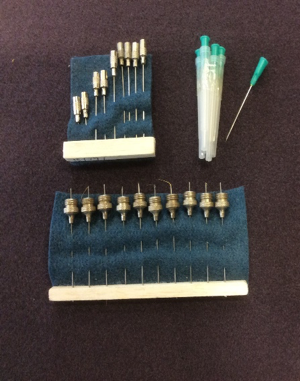


Figure 1. Figure 2. Figure 3.
Figure 4 below, shows two unused, ‘Gord’ type, infusion needles. Both are fitted with detachable rubber diaphragms to make repeated intravenous injection easier. With several minor variations they were used for many years until the 1960s when single use ‘Butterfly Needles’ were introduced.
Figure 5: This is a 1930s portable lumbar puncture set used to measure the pressure of and test the cerebrospinal fluid which flows when the spinal meninges have been punctured.
Figure 6: Haemorrhoid needles are characterised by a shoulder on the haft a few millimetres short of the needle tip to prevent deep penetration when injecting the haemorrhoids. A secure needle-lock ensured that the increased pressure required to inject the viscous oil did not detach the needle.





Figure 4. Figure 5. Figure 6.
The needles pictured below represent the range of needles and packaging which were commonplace between 1920 and 1950. They often became blunt with multiple use, were impossible to clean and sterilise adequately and caused infections leading to cellulitis and abscesses. Sharpening needles was sometimes solved by including a suitably shaped carborundum stone in the injection set. Needle sharpening devices were needed for rapid and consistent sharpening of many needles by large institutions (Figures 7. & 8.).




Figure 7. Figure 8.
Syringes and Injection Sets:
The Mussel Shell (Figure 9.), a pocket-sized syringe set, was patented by Burroughs Welcome, about 1910, particularly for use with tabloids, containing a standardised dose of soluble preparations to be injected after dissolving in distilled water. It was not until later that pharmaceutical manufacturers prepared sterile injections in sealed glass ampoules. Probably the oldest syringe in the collection (c1875) has a small metal barrel with a plain glass tube to contain a medication. It is crude and has a waxed linen piston with thumb-hold on the plunger. The needle has a screw fitting like another of the older syringes in the collection with its ferrous metal ends and non-sterilisable, ivory thumb piece on a plunger with a rubber piston. (Figure 11.)


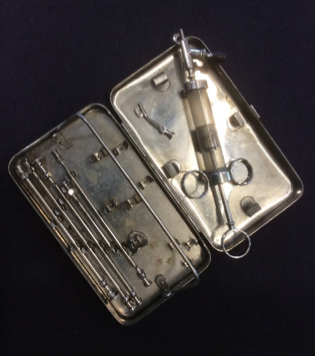


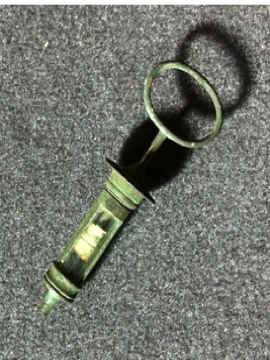
Figure 9. Figure 10. Figure 11.
There were a variety in syringes made from all glass to all metal, but the Rekordspritze introduced by the Berlin instrument makers Dewitt and Hertz in 1906 gained prominence through its dependability, lack of leakage and jamming, and ease of dismantling to enable sterilisation. This pattern persisted until plastic superseded it. It was manufactured by many companies with minor modification all over the world. All glass syringes retained some popularity but were more susceptible to jamming and leaking (Figure 13.). Cartridge syringes were popular with dentists, and for emergency kits (Figure 14.).

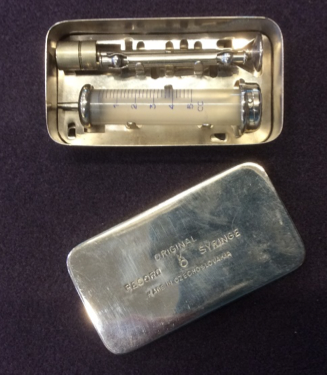
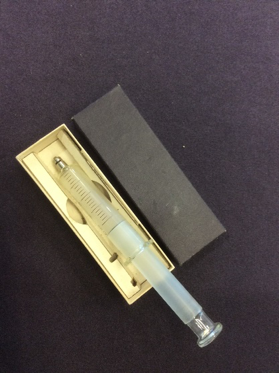
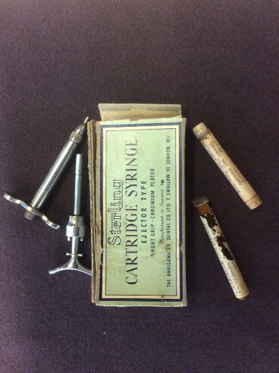
Figure 12. Figure 13. Figure 14.
The collection contains several special purpose syringes and syringe sets. The anaesthetic syringe set was in common use by GPs and specialists. (Figure 10.). One that took us a while to identify is shown in Figure 15. The copper cased cannulas and the thick metal syringe with a robust screw lock retain heat to enable the injection of melted paraffin wax into hollow organs and vessels for demonstration specimens for morbid anatomy classes. Another unusual syringe is the AGLA Micrometre Syringe Outfit shown in Figure 16. This was designed for analysis of diluted concentrations of biological fluid components where accurate measurement of precise quantities is required. The enclosed booklet suggests that it was particularly used in immunology research and assessment where serial dilutions are critical, but toxicology would suggest itself as another application.



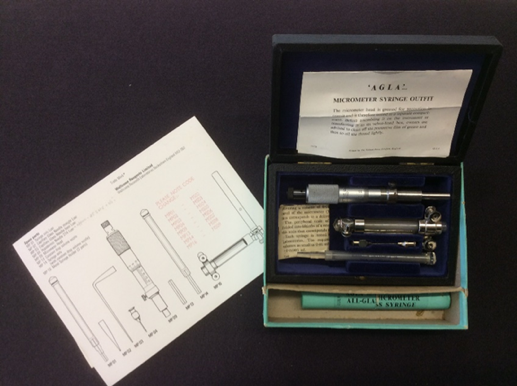
Figure 15. Figure 16.
Needles and syringes were routinely sterilised in sets, usually by simple boiling but in clinics and hospitals autoclaves were used to obtain higher temperatures. Syringe sets enabled the non-interchangeable components to be kept together. Single use items now dominate the products though occasionally glass may be used in preference to plastic because of the characteristics of the substance to be injected. However, most syringes, intravenous giving sets and intravenous catheter placement sets are made from plastic with stainless steel needles, wrapped in cellophane and sterilised using gamma irradiation (Figure 17.). Expensive modern biological pharmaceuticals are often distributed in a single dose syringe with, plastic and rubber plunger with a sealed needle incorporated into the glass barrel for self- administration. This means the syringe is the container for the medicine and reduces the chance of wastage (Figure 18). 
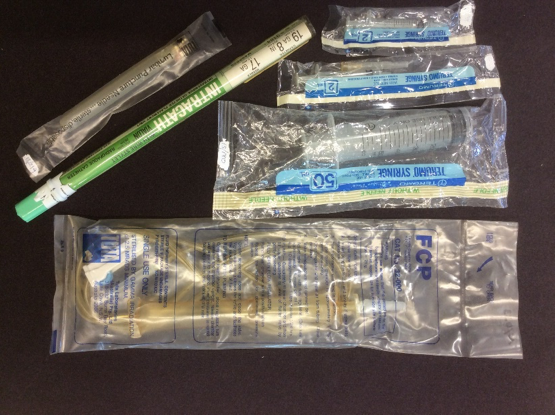

Figure 17. Figure 18.
The Marks-Hirschfeld Museum of Medical History aims to celebrate Queensland’s medical history by telling the stories of its people, events, objects, scandals and triumphs. We welcome all stories with a medical history aspect. Get in touch with us at medmuseum@uq.edu.au.

